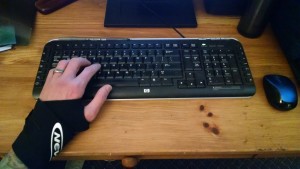 Carpal Tunnel Syndrome affects 1-5% of the population and is the most common disorder of the hands and wrists. The typical symptoms are numbness and tingling in the fingers along with weakness in the hands when trying to grip something. The symptoms tend to be worse at night when sleeping and waking up with numb hands is common. Certain activities are known to increase the likelihood that someone is going to develop Carpal Tunnel Syndrome. Anyone involved in long periods working with a keyboard is prone to develop Carpal Tunnel Syndrome. Professions like mechanics who are constantly twisting and putting stress on the wrists can also cause the symptoms.
Carpal Tunnel Syndrome affects 1-5% of the population and is the most common disorder of the hands and wrists. The typical symptoms are numbness and tingling in the fingers along with weakness in the hands when trying to grip something. The symptoms tend to be worse at night when sleeping and waking up with numb hands is common. Certain activities are known to increase the likelihood that someone is going to develop Carpal Tunnel Syndrome. Anyone involved in long periods working with a keyboard is prone to develop Carpal Tunnel Syndrome. Professions like mechanics who are constantly twisting and putting stress on the wrists can also cause the symptoms.
Carpal Tunnel Syndrome is when one of the main nerves that serve the hands is irritated or pinched somewhere along its path. This nerve originates, as they all do, from the spinal cord. In this case it starts from nerve roots at the base of the neck. It then passes near the shoulder, elbow and then through the wrist. Irritation anywhere along this path will cause numbness, tingling and weakness in the hand. This is important to note because it doesn’t just have to be irritated at the wrist for symptoms to occur so treatment, likewise, shouldn’t be just at the wrist.
When I’m watering my lawn and my son thinks it’s funny to stand on the hose back where it starts to stop the water I’m not going to be able to start the water flowing by putting on a new nozzle. I need to remove the pressure at the start of the hose and find him something else to play with.
The usual first line of treatment for Carpal Tunnel Syndrome is anti inflammatory medications and wearing a brace on the wrists to sleep. These treatments provide some people with relief but don’t address the cause of the problem. For persistent cases the last line of treatment will be surgery to cut some of the soft tissues in the wrist that are pressing on the nerve. Any surgery has its own complications and isn’t always effective. If the nerve is not being compressed at the wrist or if there is additional pressure somewhere else along the nerves path then no amount of cutting will help.
If both of my kids are standing on the hose at different points no water is going to be coming out. I need to find something for both of them to do I can’t just move one of them. Can’t they find another game to play?
This case study looked at a woman who had the classic signs of Carpal Tunnel Syndrome. She had numbness and weakness in both of her hands for nearly a year. Her pain was worse at night and would prevent her from falling asleep and wake her in the middle of the night. Her job had her sitting at a keyboard typing and using a mouse most of the day. She did not seek any of the typical treatments but sought out a Chiropractor to have her spine evaluated and adjusted to see if that would help.
Her Chiropractic exam revealed that she had subluxations, or misalignments, of the bones at the base of her neck and in one of the bones in each of her wrists. The Chiropractor treated her by adjusting the bones in her neck to improve their alignment and reduce the inflammation and irritation of those joints. This will decrease any pressure on the nerves as they exit the spine and travel down the arm. The Chiropractor also adjusted the bones in her wrists. She was seen a total of 5 times over the course of one month to be adjusted. She was also given exercises to strengthen some of the muscles in her forearms, braces to wear while sleeping and icing instructions. By the end of one month she was no longer using the braces for sleeping and was not having any pain while working at the computer.
This is another example of how Chiropractic care to improve the function of the joints in the spine can have far reaching effects. All nerves originate at the spinal cord and travel though small opening between the spinal bones. If the nerve is irritated as it exits the symptoms can show up far from the spine. In this case she was having pain in her hands and wrists. The Chiropractic adjustments of the spinal bones reduced the pressure on the nerves and reduced her Carpal Tunnel Syndrome symptoms.
It’s as simple as that.
Now if I can just find something productive for my kids to do.
By Dr Scott Szela
Ref: Annals of Vertebral Subluxation Res. Dec. 15, 2014